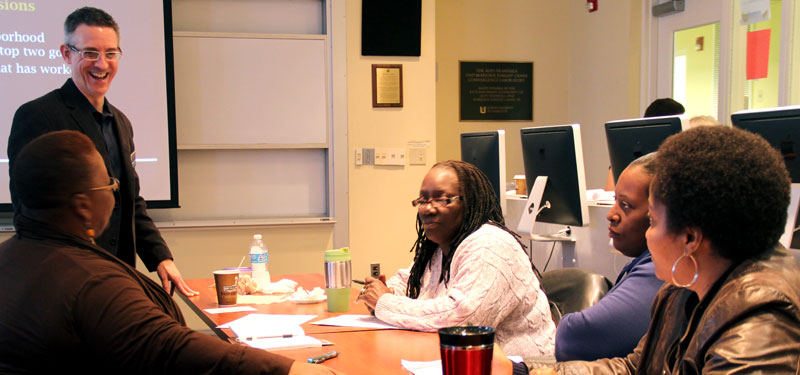The City of Charlotte and the Knight School of Communication at Queens are working together to examine how neighborhoods communicate, and how these processes strengthen communities.
A recent Digital Charlotte workshop brought together 20 representatives from 11 Charlotte neighborhoods, investigating how they currently communicate and how they might improve the process. Neighborhoods participating included Baxter Street, Cedar Lawn Farms, Clanton Park, East Charlotte, Grove Park, Hampton Hills, Hampton Leas, Weston Woods and Woodlawn Park.
Tom Warshauer, community engagement manager for the City of Charlotte, says strong communication is important for two reasons: neighborhoods need to reach inward to enable residents to get to know each other better, take care of each other, do things together and improve their quality of life. In addition, neighborhoods need to be able to tell their story externally, which helps attract their next neighbor.
“We believe it’s really important for neighborhoods to have the skills to be able to utilize technology to communicate well within their community,” Warshauer says. “One of the ways we’re trying to help people acquire those skills is in partnering with people who are really good at it, including the Knight School of Communication at Queens.
“We already have a number of neighborhoods who are doing some great work in this area. Places like Dilworth and Plaza Midwood have been out there doing this work for a long, long time. But there are other neighborhoods emerging that are telling some great stories. People in Thomasboro-Hoskins are doing some great work, and Grove Park. There are emerging business districts doing some great work, in collaboration with businesses and neighborhoods, like the North End, NoDa, Oaklawn Park, and the FreeMoreWest community, all working together to tell their story, produce events, get together, and make their communities great places to work and live.”
In the workshop, neighborhood representatives described what communication processes worked and what didn’t. What works: face-to-face communication, remembering that neighbors speak in multiple languages, and asking people what they want. What doesn’t always work: websites that don’t address residents who lack Internet access, and newsletters that aren’t timely enough for immediate events.
Aaron Sanders edits a newsletter for his neighborhood, Woodlawn Park, just north of uptown Charlotte. He also relies on email and phonemail for news distribution, and is investigating new SMS texting tools. Sanders hopes that these tactics will help his neighborhood deal with what he describes as a “tsunami of economic activity” expected to accompany the upcoming arrival of a streetcar line in north Charlotte.
“My newsletter is well-read,” Sanders says. “I have noticed that as soon as readers see it in their mailbox, they stop what they are doing and read it. It has helped me increase membership by 30 to 35 percent from when I first became the leader of the neighborhood association.”
Digital Charlotte will conduct the next Neighborhood Communication Workshop on Saturday morning, Feb. 8, 2014. Additional registration information about the workshop will become available in January.
Photo: Dr. Eric Freedman (standing), dean of the Knight School of Communication at Queens, with neighborhood representatives at a Neighborhood Communication Workshop in October 2013.
